
English playwright Caryl Churchill examines what it takes to be a “top girl” in the dog-eat-dog world we call business in her challenging, thought-provoking 1982 drama Top Girls, the terrific latest from The Antaeus Company and a tailor-made showcase for a baker’s dozen of L.A.’s finest working actresses.
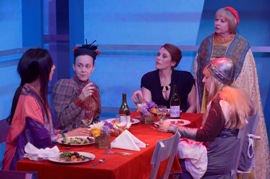 It takes only the entrance of the first several of its large cast of characters for the first of Top Girls’ several challenges to present itself, for what at first appears to be a simple celebratory dinner party for a woman recently promoted to employment agency managing director turns out to be something considerably more surreal.
It takes only the entrance of the first several of its large cast of characters for the first of Top Girls’ several challenges to present itself, for what at first appears to be a simple celebratory dinner party for a woman recently promoted to employment agency managing director turns out to be something considerably more surreal.
The five women invited to a posh London eatery to toast Marlene’s long sought-after promotion are not work colleagues, but rather a quintet of “top girls” of history and legend, a fivesome dating as far back as reputed 9th Century pontiff Pope Joan and as recently as 19th Century English explorer Isabella Bird, each with her own fascinating story to tell.
Adding to the challenges of this most famous of Top Girl’s five scenes are a pair of Churchill trademarks: characters who interrupt each other almost constantly and dueling conversations which take place at precisely the same time.
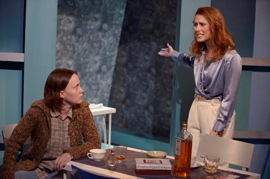 Ensuing scenes set either at Marlene’s workplace or at her sister Joyce’s Suffolk home prove considerably more realistic than the first, but here too Churchill keeps her audience on their toes. Office vignettes—a job interview here, a conversation between colleagues there—would seem at first to be nothing more than glimpses into the day-to-day goings-on at the employment agency these top girls call home. As for the pair of scenes set away from work, Churchill opts to tell these in reverse chronological order, the play’s concluding scene set a year prior to Marlene’s promotion, with nothing but the gift of a dress to cue us in to the fact that what we’re seeing actually happened the previous year.
Ensuing scenes set either at Marlene’s workplace or at her sister Joyce’s Suffolk home prove considerably more realistic than the first, but here too Churchill keeps her audience on their toes. Office vignettes—a job interview here, a conversation between colleagues there—would seem at first to be nothing more than glimpses into the day-to-day goings-on at the employment agency these top girls call home. As for the pair of scenes set away from work, Churchill opts to tell these in reverse chronological order, the play’s concluding scene set a year prior to Marlene’s promotion, with nothing but the gift of a dress to cue us in to the fact that what we’re seeing actually happened the previous year.
Still, despite its numerous challenges, Top Girls somehow manages to work, provided that audience members are willing to pay close attention and connect the dots.
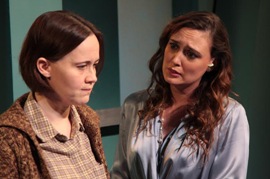 It helps immensely that director Cameron Watson and his “partner-cast” actresses do such richly developed work, taking characters who might on the surface seem fairly bare-boned and filling them out with carefully constructed back stories, making for one memorable performance after another.
It helps immensely that director Cameron Watson and his “partner-cast” actresses do such richly developed work, taking characters who might on the surface seem fairly bare-boned and filling them out with carefully constructed back stories, making for one memorable performance after another.
Sally Hughes and Rebecca Mozo alternate as Marlene, whose rise to success mirrors that of then recently elected Prime Minister Margaret Thatcher, and who shares with her more celebrated counterpart the same iron will and single-minded sense of purpose.
At the opposite end of the spectrum is Marlene’s sister Joyce (Karianne Flaathen at all performances), who holds down four cleaning jobs to support sixteen-year-old Angie (Etta Devine and Abigail Marks), a lump of a teenager whose dreams of a life like Marlene’s might come true if only she had what it takes to make it in her aunt’s world. In fact, poor Angie can’t even seem to find friends her own age, spending the bulk of her free time with a neighborhood girl (Julia Davis and Alexandra Goodman) four years her junior.
A series of short scenes introduce us to Top Girls Employment Agency top girls Win (Kimiko Gelman*) and Nell (Shannon Lee Clair and Jeanne Syquia), to job seekers Louise (Rhonda Aldrich and Elizabeth Swain), Jeanine (Clair and Syquia), and Shona (Davis and Goodman), and to Mrs. Kidd (Flaathen), the wife of the man who lost his promotion bid to Marlene.
Together these five supporting characters present a microcosm of women at work—or seeking work—in early ‘80s England. Win may have achieved success in the business world, but this top girl has gotten herself involved with a married man who seems disinclined to pop the question anytime sooner or later. Tough-as-nails top girl Nell may be dating two men at the moment, but it’s doubtful either one of them will convince her to trade the workplace for home and hearth. Jeanine’s dreams of marriage and children quickly convince Marlene of the unlikelihood of her making in the business world. Middle-aged Louise has seen one man after another promoted above her while remaining permanently stuck in middle management. Shona spins tall tales about her extensive work experience in order to impress, but is clearly out of her depth in her job interview with balls-of-steel Nell. Mrs. Kidd believes that if she just talks to Marlene woman-to-woman, she might be able to get the newly promoted top girl to step aside. (As if.)
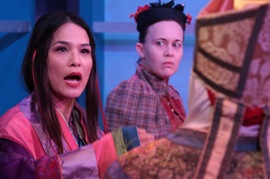 As for the women with whom Marlene shares her celebratory dinner, while Churchill lets each provide sufficient biographical details for the attentive audience member to piece together the lives led by Dull Gret (Devine and Marks), Isabella Bird (Flaathen), Lady Nijo (Gelman*), Patient Griselda (Clair and Syquia), and Pope Joan (Aldrich and Swain), a program insert would be useful for those not having done their pre-show research. (This reviewer had fortunately done his background checks.) Still, regardless of how much you know going in, by the end of Top Girl’s dreamlike opening scene, it’s become clear why Marlene would choose to celebrate her promotion with these five women, each one in her own way a “top girl” of her time.
As for the women with whom Marlene shares her celebratory dinner, while Churchill lets each provide sufficient biographical details for the attentive audience member to piece together the lives led by Dull Gret (Devine and Marks), Isabella Bird (Flaathen), Lady Nijo (Gelman*), Patient Griselda (Clair and Syquia), and Pope Joan (Aldrich and Swain), a program insert would be useful for those not having done their pre-show research. (This reviewer had fortunately done his background checks.) Still, regardless of how much you know going in, by the end of Top Girl’s dreamlike opening scene, it’s become clear why Marlene would choose to celebrate her promotion with these five women, each one in her own way a “top girl” of her time.
Not every theatergoer will take to Top Girls’ structure. Individual scenes may have some in the audience scratching their heads and wondering what the blazes Churchill is getting at, and the playwright’s decision to end the play a year back in time does make the final fadeout seem a tad anticlimactic.
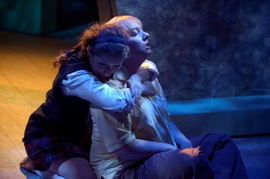 Still, if Top Girls merits this Antaeus Company production (and a high-profile Broadway revival a half-dozen years ago), it is because there is method in Churchill’s apparent madness—and because few plays have offered meatier roles for actresses too often shortchanged when great parts get written.
Still, if Top Girls merits this Antaeus Company production (and a high-profile Broadway revival a half-dozen years ago), it is because there is method in Churchill’s apparent madness—and because few plays have offered meatier roles for actresses too often shortchanged when great parts get written.
As always, Antaeus has double-cast Top Girls, with the two ensembles rehearsing in tandem. Not only does this aid in creating characters made all the richer through collaboration, it allows one “partner” or the other to take the afternoon or evening off when a paying gig comes along, as on Opening Night when Gelman stepped in for Linda Park while the latter was shooting a pilot.
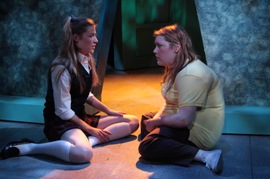 Saturdays and Sundays see “High Flyers” and “Ball Breakers” performing as separate and distinct ensembles, with Thursdays and Fridays offering various mash-ups of the two casts. Regardless of the day, audiences are guaranteed to see seven actresses performing at the peak of their craft. Both casts are equally marvelous, and though each actress does indeed have her own take on her role(s), whether you see High Flyers Aldrich, Devine, Hughes, Flaathen, Goodman, Park, and Syquia or Ball Breakers Clair, Davis Flaathen, Gelman, Marks, Mozo, and Swain (or some combination of the two casts), these are women at the peak of their craft delivering one splendid performance after another.
Saturdays and Sundays see “High Flyers” and “Ball Breakers” performing as separate and distinct ensembles, with Thursdays and Fridays offering various mash-ups of the two casts. Regardless of the day, audiences are guaranteed to see seven actresses performing at the peak of their craft. Both casts are equally marvelous, and though each actress does indeed have her own take on her role(s), whether you see High Flyers Aldrich, Devine, Hughes, Flaathen, Goodman, Park, and Syquia or Ball Breakers Clair, Davis Flaathen, Gelman, Marks, Mozo, and Swain (or some combination of the two casts), these are women at the peak of their craft delivering one splendid performance after another.
As for the design team assembled for Top Girls, they don’t come any better than Jeff Thomas Gardner & Ellen Mandell (sound design/original compositions), Stephen Gifford (scenic design), Terri A. Lewis (costume design), Jared A. Sayeg (lighting design), and Alyson Schultz (properties design). Gifford’s stunning angular set pieces come together in an astonishing variety of permutations, lit gorgeously (and scene-specifically) by Sayeg, with Shultz’s meticulously chosen properties adding the finishing touches. (Special kudos to the full-course dinner served at every performance and to cast members Davis and Goodman for their serving skills.) Lewis has had a field day creating multi-period costumes for Top Girls’ historical figures and big-shouldered ‘80s wear for Marlene and her contemporaries. Gardner and Mandel get top marks as well, particularly for their edgy musical soundtrack. Throughout the production, Nike Doukas works her usual dialect coaching magic.
Providing behind-the-scenes support are Kristin Weber (assistant stage manager and wardrobe), Chris Osborne (production electrician), R. Scott Thompson (technical director), Adam Meyer (production manager), Tennyson Stead, Spencer Rowe, and Michael Hyland (electricians), Red Colgrove and Colgrove Scenery (set construction), Maureen Lenker and Shaina Rosenthal (assistant directors) and Orlando de la Paz (scenic painter).
By far the most contemporary of the fourteen Antaeus Company productions I’ve reviewed, Top Girls is also one of the most challenging, and not merely for director, actors, and designers. Audience members must stay alert throughout, Caryl Churchill not making it easy for any of the above. Still, for those willing to put forth the effort, Top Girls represents L.A. theater at its most top drawer.
*at both performances reviewed
The Antaeus Company, 5112 Lankershim Blvd., North Hollywood.
www.Antaeus.org
–Steven Stanley
March 13 and 16, 2014
Photos: Daniel G. Lam
Tags: Caryl Churchill, Los Angeles Theater Review, The Antaeus Company, Top Girls


 Since 2007, Steven Stanley's StageSceneLA.com has spotlighted the best in Southern California theater via reviews, interviews, and its annual StageSceneLA Scenies.
Since 2007, Steven Stanley's StageSceneLA.com has spotlighted the best in Southern California theater via reviews, interviews, and its annual StageSceneLA Scenies.







 COPYRIGHT 2025 STEVEN STANLEY :: DESIGN BY
COPYRIGHT 2025 STEVEN STANLEY :: DESIGN BY